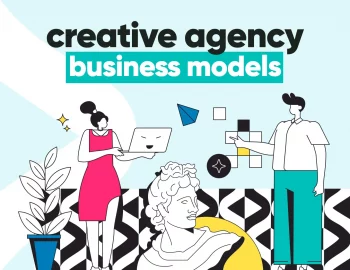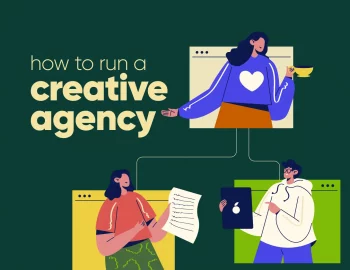Running a creative studio? Then you already know – it’s equal parts thrilling and what the heck am I doing? And hey, even if you trip up – that’s normal. Everyone makes mistakes – knowing how to avoid them the next time, though, is a big part of what makes a creative agency successful in the long run.
And if you’re in the thick of growing pains, a heads-up from those who’ve been there can save you a ton of stress. So, let’s talk about the mistakes that are best to avoid – the ones that sneak in quietly but cause real agency chaos later. No judgment here, just friendly advice to help you build smarter and breathe easier.
1. Saying ‘Yes’ to every client
When you’re trying to grow, turning down a project can feel impossible. Maybe the budget’s low, the timeline’s wild, or something just feels… off. But you say yes anyway, because hey – work is work, right?
The problem? Not all clients are good clients. Taking on anyone and everyone often leads to stress, scope confusion, and misaligned expectations. What starts as a small compromise can quickly grow into a morale-killing mess for you and your team.
Start by defining your non-negotiables – budget minimums, values alignment, and project type. Then, build a simple client fit checklist. Use it during discovery calls to filter opportunities and protect your creative energy.
2. Underpricing projects and services
Here’s a hard truth: Undercharging doesn’t make you generous, it makes your business unsustainable. A lot of agency founders start by pricing low to win customers or “be nice,” especially if they’re transitioning from freelancing. But that habit quickly leads to scope creep, resentment, and super-thin margins.
Even worse, underpricing can attract clients who undervalue your work, which only reinforces the cycle.
Price for the value you’re delivering, not just the time invested. Use anchor pricing, offer tiered packages, and add buffer time to every quote. And remember: saying no to low-budget projects opens space for the right ones to come in.
3. Not defining (or documenting) the scope clearly
If you’ve ever found yourself halfway through a project wondering how it ballooned into way more than you agreed on… you’re not alone. Scope creep is a sneaky stressor, especially when you’re trying to keep clients happy and processes aren’t fully locked in.
Vague proposals, loose timelines, or “just one more thing” requests can derail even the best intentions.
Get crystal clear upfront. Break down deliverables, rounds of revisions, timelines, and what’s not included. Use project kickoff calls to walk through it all and get sign-off. And when clients ask for some extra job or asset? No problem – just send a quick change order and adjust the timeline or cost accordingly.
4. Trying to be everything to everyone
When your company’s growing, it’s tempting to say, “Sure, we can do that!” – even if it’s outside your expertise. You want to be helpful, flexible, and easy to work with. But trying to please everyone usually ends up pleasing no one (including your team).
Stretching your services too wide dilutes your positioning and confuses potential clients. Plus, it can burn out your employees if they’re constantly trying to fix the capability gaps.
Get clear on your agency’s “sweet spot” – the type of work and specific areas that energize your team, deliver real value, and bring in profit. Stick to it. You don’t have to be everything to achieve success. You just have to be really good at the right things.
5. Skipping contracts or using vague ones
I get it – contracts aren’t exactly thrilling. When you’re excited to start a new project (or you’ve built some trust already), it can feel like a formality. But avoiding the contract (or using a super basic one) is one of the biggest mistakes agencies make. Businesses that follow such practice usually pay the cost down the line.
Without clear terms, things like payment schedules, intellectual property, revisions, or kill fees can get shady fast.
Always use a contract. Not a DIY Google Doc – an actual, reviewed-by-a-lawyer agreement. It should spell out what’s included, what’s not, timelines, responsibilities, and what happens if the project pauses or ends early. A solid contract doesn’t scare good clients off – it gives everyone peace of mind.
6. Ignoring the numbers that matter
Creative agencies tend to attract visionaries, not accountants. Which is why it’s way too common for small studios to run on instinct instead of insight. You’re focused on the work, the people, the client experience, and spreadsheets feel like a buzzkill. But here’s the truth: ignoring your numbers is like flying blind.
You might feel busy and booked, but are your projects actually profitable? Do you know which clients are bringing in real profit margin and which ones are secretly draining your resources and finances? Without clarity on the data, it’s nearly impossible to grow in a sustainable, smart way.
You don’t need an MBA. Just start tracking the essentials: Which project types are most profitable? What’s your average revenue per employee? How much of your team’s time is billable vs. admin-heavy? Tools like Harvest, for example, or even a simple spreadsheet can reveal patterns that help you make sharper decisions and create better strategies.
Creativity thrives best when your business is healthy, and that starts with knowing your numbers.
7. Overlooking the power of a clear process
When you’re a tiny team, it’s easy to default to “we’ll figure it out as we go.” And that works – for a while. But without defined processes, things (and quality) start slipping through the cracks. Deadlines get fuzzy, clients get confused, and your team wastes valuable time.
A lack of structure doesn’t feel creative – it feels chaotic.
You don’t need to systematize everything overnight. Just pick one core area, like onboarding or revisions, for example, and write down the steps. Then test and tweak it. Document as you go. Your future agency, self, and team will thank you.
8. Micromanaging or doing it all yourself
When you’ve built your agency from the ground up, it’s hard to avoid being in the weeds – you know the vision, the standard, the tone, and you want no mistakes. So you keep managing every deliverable, rewriting proposals, and jumping in “just for a sec.”
But doing it all yourself isn’t just exhausting – it slows everyone down. And your employees? They feel like they’re being second-guessed, even when that’s not your intention.
Besides delegating tasks, start delegating outcomes. Instead of “design this,” try “own this client presentation.” Let people surprise you (in the best way). Build trust through small wins and give your team space to grow – even if it’s a little messy at first.
9. Hiring reactively (instead of strategically)
Client lands a big project, and suddenly you’re scrambling to find a freelancer or hire someone yesterday. It’s totally understandable, but reactive hiring often leads to mismatched fits, unclear roles, and rushed onboarding.
The result? You end up spending more time fixing things than if you’d just waited or planned ahead.
Hire for the agency you want to become, not just today’s needs. Think in terms of roles (creative lead, account manager) instead of temporary deficiencies. Create a hiring wishlist and define your next key roles before you’re desperate. That way, when the right person pops up, you’re ready.
10. Ignoring internal communication habits
In a small creative team, it’s easy to rely on quick Slack messages or just synchronizing in meetings. But over time, inconsistent communication in creative agencies leads to dropped balls, more mistakes, repeated questions, and a general feeling of “guys, who’s doing what,” which hence leads to avoiding responsibility.
Even worse, it creates stress and frustration, especially for people who need clarity to do their finest, high-quality work.
Create simple, regular touchpoints. A weekly team huddle. A Monday morning check-in doc. A shared project management tool‘s board where everything lives. Consistency doesn’t kill creativity – it gives it room to breathe.
11. Letting clients drive the timeline
It starts with one little delay – “We’ll get feedback to you by Friday.” Then it’s Monday. Then Wednesday. And suddenly, your agency’s juggling five delayed projects at once, all trying to launch at the same time. Not exactly a dream scenario, is it?
When clients set the pace (or stall it), it creates a domino effect that throws off your entire production schedule, and ultimately your sanity.
Set expectations early and often. Build timelines that include client responsibilities and set clear review deadlines. If feedback is late, pause the timeline and communicate the impact.
Bonus tip: Include a clause in your contract for stalled projects or late approvals so you’re not left hanging.
12. Relying too heavily on one client
It’s the classic “all your eggs in one basket” trap. When one client accounts for a big chunk of your business revenue – say, 30% or more – you might feel secure, but you’re actually standing on a shaky foundation. If that client suddenly pauses, leaves, or shifts direction, your entire agency could feel the impact overnight.
At the same time, swinging too far the other way – trying to cover every industry, offering everything to everyone – can weaken your positioning and drain your focus. It’s a tricky balance.
Aim to keep any single client under 15% of your total revenue. If someone starts creeping past that mark, use it as a cue to pursue more new business and diversify your client base.
And when it comes to expanding your services, do it slowly and intentionally. Look for overlap between what you already do well and where the market is heading. For example, if you specialize in branding, branching into packaging or content strategy might be a more natural next step than, say, launching a social media marketing division from scratch.In short, build stability by spreading risk and staying focused on what you do best.
13. Skipping post-project reviews
Once a project wraps, it’s tempting to celebrate success and move on – next! But if you never pause to reflect, you miss out on priceless insights. What went smoothly? Where did things go sideways? How did the client feel?
If you make such retrospectives for your agency, you’re likely to avoid repeating the same mistakes next time.
Make project debriefs a habit. Keep it light but structured – what worked, what didn’t, what to try differently next time. Bring in feedback from your employees and the client. It’ll sharpen your process, strengthen relationships, and surface opportunities and ideas you might’ve missed.
14. Neglecting your own brand and marketing
When work is flowing, it’s easy to push your brand to the back burner. But when things slow down? Suddenly, you’re scrambling to update your portfolio or post on LinkedIn. And the cycle repeats.
Treating your own brand like an afterthought keeps you stuck in feast-or-famine mode.
Block time to work on your agency, not just in it. Whether it’s updating your case studies, writing content, or nurturing leads, consistency compounds. Schedule an internal marketing audit just like client work, and give your agency the love it deserves. After all, you’re your best case study.
Bottom line
Running a creative agency is no small feat – it’s part passion project, part business experiment, and part rollercoaster – and mistakes are simply part of the ride, luckily, one you can avoid. But spotting those sneaky patterns (like overcommitting, underpricing, or clinging too tightly to one client) early on? That’s how you build something resilient.
The good news? Most of these common agency mistakes are fixable or avoidable. Often, it just takes a pause, a shift in mindset, and a few process tweaks to set things right. So if a few of these hit close to home, just know you’re not alone. You’re just growing.
Here’s to building an agency that lasts, without burning out the people behind it!
If you want more tips and insights on how to make your creative agency thrive, check out our other helpful resources:





